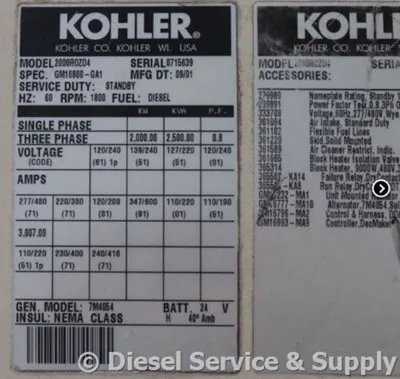Choosing the correct power rating for a generator engine is essential to ensure reliable and efficient performance. While the intended use may seem straightforward, several factors must be considered before purchasing a generator. This guide explains the proper application of generator engine ratings in AC generator set installations, including standby, prime, and continuous power ratings.
Power Ratings Overview

Standby Power Rating
- Primary Application: Designed for emergency power during utility outages.
- Key Characteristics:
- No overload capability.
- Should not run in conjunction with public utility power.
- Usage Guidelines:
- Sized for a maximum of 80% average load factor.
- Operates up to 200 hours per year, with less than 25 hours at the standby rating.
- Only applied during true emergency outages, not during planned outages or load testing.
- Compliance:
- Manual load shifts can be performed for testing using automatic transfer switches.
- Not intended for continuous or heavy-duty use.
Prime Power Rating

1. Indefinite Running Time
- Definition: Maximum power available at variable load for unlimited hours per year.
- Usage Guidelines:
- The average variable load should not exceed 70% of the prime power rating over 250 hours.
- Running at 100% prime power is limited to 500 hours annually.
- Includes a 10% overload capability for up to 1 hour within a 12-hour cycle.
- Ideal Applications:
- Off-grid locations require consistent but variable power, such as construction or remote operations.
2. Limited Running Time
- Definition: Prime power available for a set number of hours in non-variable load conditions.
- Usage Guidelines:
- Operates up to 750 hours per year without exceeding the prime power rating.
- Not recommended for high load use exceeding 750 hours annually.
- Ideal Applications:
- Planned power outages, temporary utility reductions, or backup scenarios.
Continuous Power Rating
- Definition: Power provided at 100% load for unlimited hours annually.
- Usage Guidelines:
- Designed for constant, full-load applications.
- Ideal Applications:
- Remote or off-grid operations, including mining, agriculture, and military uses.
- Advantages:
- Built to handle demanding, uninterrupted workloads, ensuring durability and efficiency.
The Impact of Elevation and Temperature on Power Ratings
Elevation Considerations
- Standby Power Rating:
- Operates at altitudes up to 3,000 ft. without deration.
- Prime Power Rating:
- Operates at altitudes up to 5,000 ft. without deration.
- Continuous Power Rating:
- Requires performance reduction by 3% per 1,000 ft. above rated altitude.
Temperature Considerations
- Engines can handle temperatures up to 100°F without deration for standby and prime ratings.
- For continuous duty, performance decreases by 1% per 10°F increase above rated temperature.
Summary of Adjustments:
- Altitude: Reduce power output by 3% per 1,000 ft. for continuous duty.
- Temperature: Reduce power output by 1% per 10°F above standard conditions.
Standards and Consultation
- Reference Standards:
- ISO 3046
- BS 5514
- DIN 6271
- Professional Guidance:
- Consult an electrical contractor or generator specialist to determine the appropriate generator rating for your needs.
- Proper assessment ensures optimal performance and longevity for your generator.